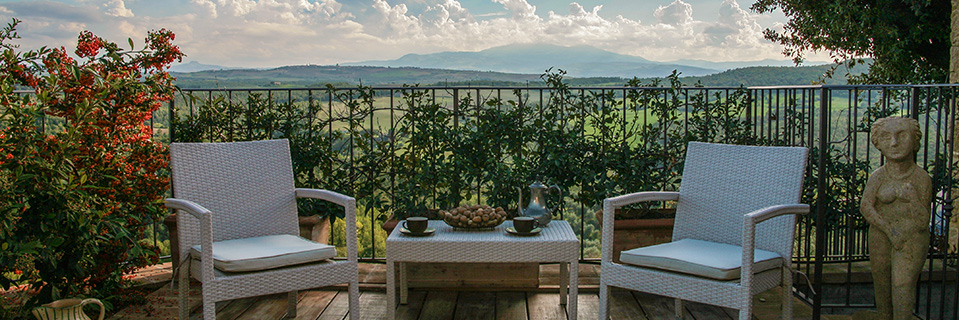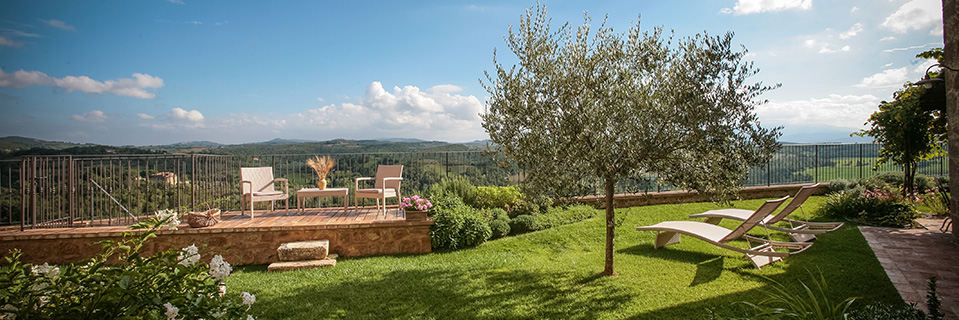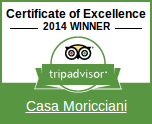The Valley of the Orcia River, known as the Val d'Orcia, is pristine and will remain that way because it has been declared a "world heritage site" by UNESCO (United Nations Education, Scientific, and Cultural Organization). The Italian government further protects it by designating this area as the Artistic, Natural, and Cultural Park of the Val d'Orcia.
The Val d'Orcia is the home to the great red wines of Brunello di Montalcino and Vino Nobile di Montepulciano. Its soils are perfect for olive oil and pecorino cheese. Here you will taste the lush foods and fresh ingredients of the "cucina povera", the traditional Tuscan dishes that truly are the best "comfort foods" in the entire world.
You have seen Val d'Orcia's vistas and villages in the movies, for they have appeared as both backdrop and character for sumptuous movies such as The Gladiator, The English Patient, Romeo and Juliet, A Midsummer Night's Dream, and Stealing Beauty. The fields caressed by Russell Crowe in the Gladiator are just below the walls of Pienza; the palace where the Capulets lived in Zeffirelli's Romeo and Juliet was the Palazzo Piccolomini in the heart of Pienza; and the monastery where The English Patient was cared for by Juliette Binoche is set at Sant'Anna in Camprena just a few miles outside of Pienza.
The Val d'Orcia is the quintessential landscape of Tuscany that has lured great writers and poets, photographers, and cinematographers to capture its beauty in an attempt to transmit its ancient rhythms and secrets to others. But the Val d'Orcia must be experienced personally in a languid, sensual, and aesthetic manner. You must come to this valley yourself to see the colors of its sunsets, its changing meadow hues, its bright red poppies and yellow broom flowers, its tiny travertine marble chapel, its solitary stands of cypress trees, and its medieval hilltop villages. It is only here that you can breathe in its history, its people, and its ancient beauty.
Towns of the Val d'Orcia and driving distance from Castelmuzio
Pienza (12 minutes drive)
Pienza is a magical place to visit and filled with romance. Zeffirelli filmed his acclaimed version of Romeo and Juliet in Pienza, no doubt choosing this beautifully preserved Renaissance gem for its outstanding architecture and its incomparable setting.
Pienza's center was completely redesigned by Pope Pius II in Renaissance times, and it was seen as an 'utopian town' by the Italian people. It has changed little since then, with a great number of ornate, centuries-old buildings packed into a relatively small area.
The cathedral was designed by the architect Rossellino in 1459. Its outstanding features are huge stained glass windows, dazzling Sienese altarpieces in the chapels and 16th century tapestries in the crypt.
The Papal Palace, the Palazzo Piccolomini, is adjacent to the cathedral. Its apartments, which were occupied by the Pope's descendants until 1968, are open to the public. A dazzling hanging garden and arcaded courtyard lie directly behind the palace, offering spectacular views of the valley.
On the outskirts of Pienza is a Romanesque parish church that is well worth visiting, the Pieve di Corsignano. Pope Pius II, whose legacy can be seen everywhere in Pienza, was baptized here.
San Quirico d'Orcia (20 minutes drive)
Located on the ancient Roman road, the Via Cassia, this well preserved village holds maximum charm, lots of history, and wonderful shops that appeal to both tourists and to the locals–however, it is remarkably "untouristy", and therefore a delightful village to spend some time. It was here that Federico Barbarossa of Germany (or Frederick the Red Beard), in 1155, met with the Pope's emissaries to finalize discussions to become Emperor of the Holy Roman Empire.
Pilgrims from all over Europe travelled through San Quirico d'Orcia using the Via Francigena (which follows closely the Via Cassia) to go to Rome, home of the Holy See, since as early as the late 900s.
San Quirico's most important structure is the Collegiata Church. Also within its largely preserved city walls is a beautiful public garden, Horti Leonini and Rose Garden.
Montalcino (40 minutes drive)
This beautiful medieval village is perched high on a hill with spectacular views of the entire Val d'Orcia and even to Siena. The Ferrari of Italian wines is grown and created only in this small area–the Brunello di Montalcino!
Be sure to roam the huge fortress that kept its citizens safe through centuries of battles, but unfortunately could not prevent Florence from defeating the Republic of Siena once and for all in 1559. Today you may visit inside the fortress a wine-tasting bar to taste the incredible Brunello and also the Rosso di Montalcino! In October, the Festival of the Thrush is a festival that commemorates the history of Montalcino, its dependence on the courage of its archers in historical battles and its hunters that provided food for its people.
Several kilometers outside Montalcino is Sant'Antimo, the monastery which tradition says was first established by the Emperor Charlemagne. In this serene medieval church, several times each day, the monks gather in the sanctuary and sing Gregorian chants, and the public is welcome to attend.
Castiglione d'Orcia (35 minutes drive)
Castiglione d'Orcia is an ancient town set high on a hill near Monte Amiata, in the middle of the Val d'Orcia, between Pienza and Montalcino.
The village, dominated by the imposing Citadel (Rocca degli Aldobrandeschi), keeps its medieval flavor intact. A travertine well dating from the 1600s, stands in the middle of this picturesque Tuscan piazza named after the painter, sculptor, goldsmith and architect Lorenzo di Pietro, called il Vecchietta, a local artist from the 1400s.
The Citadel of the Orcia (or Rocca di Tentennano) in Rocca d'Orcia, a tiny fraction within the same municipality, can be seen in the near distance facing the Rocca degli Aldobrandeschi and it was the most famous fortification in the area because of its strategic position overlooking the Via Cassia leading to Rome and Siena.
The Church of the Saints Stefano and Degna is a Romanesque building with a façade dating from the 1500s. Also worth a visit is the Church of Santa Maria Maddalena, with a Romanesque stone façade, dating from the 1200s.
If you are an orchid enthusiast, be sure to explore the woods around Castiglione d'Orcia because there are at least 50 of the 86 varieties of orchids found in Italy, some of them very rare, blooming from April to June.
Radicofani (50 minutes drive)
The town clings to cliffs located just below a strange and remarkable volcanic peak which can be seen from the full length of the Val d'Orcia! The village was once the headquarters of the Italian Robin Hood, Ghino di Tacco, a highwayman who "stole from the rich to give to the poor", and who was immortalized by both Dante and Boccaccio in The Divine Comedy and The Decameron. His statue stands proudly in the public park, overlooking the countryside!
The village boasts two churches with beautiful terracotta sculptures from the Della Robbia family workshop: San Pietro and Santa Agata. These stunning blue-and-white glazed altarpieces should not be missed.
The palace of the Medici family, "La Posta", is located on the edge of the village–built in the late 1500s–and has been a visiting place of many famous people over the centuries including several popes, Nathaniel Hawthorne, Charles Dickens, and Chateaubriand.
A visit to Radicofani wouldn’t be complete without climbing its great medieval tower that tops the fortress. On a clear day you may see as far as Lakes Trasimeno and Bolsena, the Apennine mountain range, and perhaps even to the Tyrrhenian Sea!
OUR OTHER PROPERTIES
FOOD & HEALTH

Casa Moricciani
di Isabella Barlocher
Via Gaetano Milanesi, 13
53020 Castelmuzio (Siena)
Tel./Fax (+39) 0578. 748083
Cell (+39) 338. 7409245
(Isabella-English/German)
Cell (+39) 339. 6640060
(Carlo-Italian/French)
Email: info@casamoricciani.com
P. IVA 01299880524









